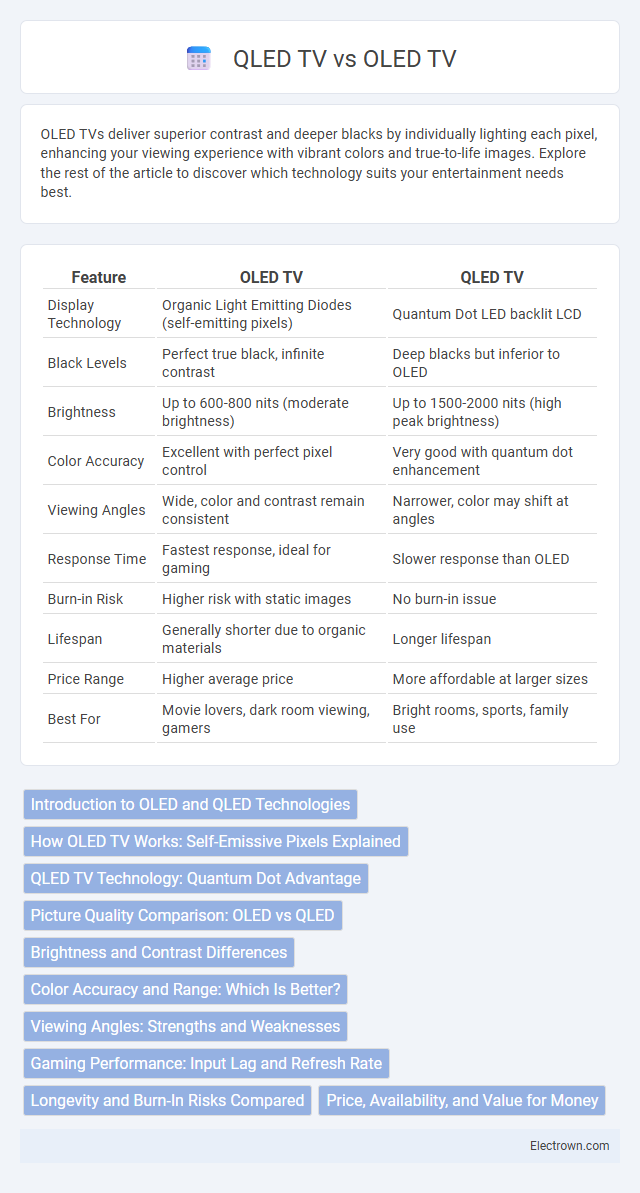OLED TVs deliver superior contrast and deeper blacks by individually lighting each pixel, enhancing your viewing experience with vibrant colors and true-to-life images. Explore the rest of the article to discover which technology suits your entertainment needs best.
Table of Comparison
| Feature | OLED TV | QLED TV |
|---|---|---|
| Display Technology | Organic Light Emitting Diodes (self-emitting pixels) | Quantum Dot LED backlit LCD |
| Black Levels | Perfect true black, infinite contrast | Deep blacks but inferior to OLED |
| Brightness | Up to 600-800 nits (moderate brightness) | Up to 1500-2000 nits (high peak brightness) |
| Color Accuracy | Excellent with perfect pixel control | Very good with quantum dot enhancement |
| Viewing Angles | Wide, color and contrast remain consistent | Narrower, color may shift at angles |
| Response Time | Fastest response, ideal for gaming | Slower response than OLED |
| Burn-in Risk | Higher risk with static images | No burn-in issue |
| Lifespan | Generally shorter due to organic materials | Longer lifespan |
| Price Range | Higher average price | More affordable at larger sizes |
| Best For | Movie lovers, dark room viewing, gamers | Bright rooms, sports, family use |
Introduction to OLED and QLED Technologies
OLED TVs utilize organic light-emitting diodes that emit light individually for each pixel, enabling true black levels and infinite contrast ratios. QLED TVs incorporate Quantum Dot technology combined with LED backlighting to enhance brightness and produce vivid colors. Both technologies employ distinct methods for image rendering, impacting display quality and viewing experience.
How OLED TV Works: Self-Emissive Pixels Explained
OLED TVs use self-emissive pixels, each composed of organic compounds that emit light when an electric current passes through them, enabling precise control of brightness and color at the pixel level. This technology eliminates the need for a backlight, resulting in true blacks and enhanced contrast compared to traditional displays. Your viewing experience benefits from deeper color accuracy and improved efficiency, especially in dark scenes.
QLED TV Technology: Quantum Dot Advantage
QLED TV technology utilizes quantum dots, microscopic semiconductor particles that emit precise colors when illuminated, enhancing brightness and color accuracy significantly compared to traditional LED TVs. This quantum dot advantage allows QLED TVs to deliver vivid images with higher peak brightness levels and better color volume, making them ideal for viewing in well-lit rooms. Your viewing experience benefits from rich, lifelike visuals with improved durability and reduced risk of burn-in compared to OLED displays.
Picture Quality Comparison: OLED vs QLED
OLED TVs deliver superior picture quality with infinite contrast ratios and perfect blacks due to their self-emissive pixels, enhancing your viewing experience with deeper shadows and vibrant colors. QLED TVs offer brighter displays and better color volume, especially in well-lit rooms, by using quantum dot technology to enhance brightness and color accuracy. Choosing between OLED and QLED depends on your preferences for contrast depth versus brightness and room lighting conditions.
Brightness and Contrast Differences
OLED TVs offer exceptional contrast ratios with true blacks, thanks to their self-emissive pixels that can switch off individually, creating deep, rich images. QLED TVs, on the other hand, excel in brightness levels due to their quantum dot technology, making them ideal for well-lit rooms and HDR content. When choosing your TV, consider OLED for superior contrast and cinematic viewing, while QLED provides higher brightness for vibrant, well-lit environments.
Color Accuracy and Range: Which Is Better?
OLED TVs deliver superior color accuracy and a wider color range thanks to their self-emissive pixels that produce true blacks and vibrant hues, resulting in more lifelike images compared to QLEDs. QLED TVs, enhanced with quantum dot technology, offer impressive brightness and color volume, particularly excelling in well-lit environments but may fall short in deep black levels. For your viewing experience, OLED is generally better if color precision and contrast are your top priorities.
Viewing Angles: Strengths and Weaknesses
OLED TVs offer superior viewing angles with consistent color accuracy and brightness even from extreme side angles, making them ideal for group viewing in wide spaces. QLED TVs tend to lose color vibrancy and contrast when viewed off-center due to their reliance on backlighting and quantum dot technology. Your choice should consider how often you watch TV from various seating positions to maximize picture quality.
Gaming Performance: Input Lag and Refresh Rate
OLED TVs typically offer lower input lag and faster response times, making them ideal for competitive gaming where every millisecond counts. QLED TVs boast higher refresh rates and better brightness levels, enhancing fast-paced game visuals and reducing motion blur. Your gaming experience benefits from OLED's smooth pixel transitions, while QLED delivers vibrant colors and sharp details during high-speed action.
Longevity and Burn-In Risks Compared
OLED TVs offer superior contrast and color accuracy but have a higher risk of burn-in due to their organic pixel structure, which can degrade over time with static images. QLED TVs utilize an LCD panel with a quantum dot filter, resulting in longer longevity and significantly reduced burn-in risk, making them more suitable for prolonged use and static content. Your choice depends on prioritizing vibrant picture quality with careful usage (OLED) or durability and consistent performance (QLED).
Price, Availability, and Value for Money
OLED TVs generally come at a higher price point than QLED TVs due to their advanced self-emissive technology, which delivers superior contrast and deeper blacks. QLED TVs are more widely available across various brands and price ranges, offering good color accuracy and brightness at a more affordable cost. For value for money, QLED TVs appeal to budget-conscious consumers seeking vibrant displays, while OLED TVs cater to those prioritizing premium picture quality and viewing experience.
OLED TV vs QLED TV Infographic

 electrown.com
electrown.com